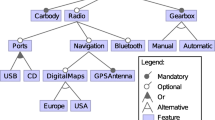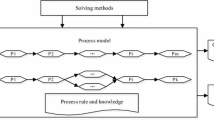Abstract
In this paper, the product configuration problems that are characterized by cardinality-based configuration rules are dealt with. Novel configuration rules including FI and EI rules are presented to clarify the semantics of inclusion rules when cardinalities and hierarchies of products are encountered. Then, a configuration graph is proposed to visualize structural rules and configuration rules in product configuration problem. An encoding approach is elaborated to transform the configuration graph as a CSP (Constraint Satisfaction Problem). As a consequence, existing CSP solver, i.e. JCL (Java Constraint Library), is employed to implement the configuration system for product configuration problem with cardinality-related configuration rules. A case study of a bus configuration is used throughout this paper to illustrate the effectiveness of the presented approach.
Similar content being viewed by others
References
Aldanondo M., Hamou K. H., Moynarda G., Lamothe J. (2003) Mass customization and configuration: Requirement analysis and constraint based modeling propositions. Integrated Computer-Aided Engineering 10(2): 177–189
Aldanondo M., Vareilles E. (2008) Configuration for mass customization: How to extend product configuration towards requirements and process configuration. Journal of Intelligent Manufacturing 19: 521–535
Anselma, L., & Magro, D. (2003). Dynamic problem decomposition in configuration. In Proceedings of configuration workshop, 18th international joint conference on artificial intelligence (IJCAI-03) (pp. 21–26). Mexico: Acapulco.
Barker V. E., O’Connor D. E., Bachant J., Soloway E. (1989) Expert systems for configuration at digital: XCON and beyond. Communications of the ACM 32(3): 298–318
Barták R., Salido M. A, Rossi F. (2010) Constraint satisfaction techniques in planning and scheduling. Journal of Intelligent Manufacturing 21(1): 5–15
Czarnecki, K., & Kim, C. H. P. (2005). Cardinality-based feature modeling and constraints: a progress report. In Proceedings of international workshop on software factories. California: San Diego.
Felfernig A., Friedrich G., Jannach D. (2000) UML as domain specific language for the construction of knowledge-based configuration systems. International Journal of Software Engineering and knowledge Engineering 10(4): 449–469
Felfernig A., Friedrich G., Jannach D. (2002) Conceptual modeling for configuration of mass-customizable products. Artificial Intelligence in Engineering 15(2): 165–176
Fohn S. M., Liau J. S., Greef A. R., Young R. E., O’Grady P. J. (1995) Configuring computer systems through constraint-based modeling and interactive constraint satisfaction. Computers in Industry 27(1): 3–21
Hong G., Hu L., Xue D., Tu Y. L., Xiong Y. L. (2008) Identification of the optimal product configuration and parameters based on individual customer requirements on performance and costs in one-of-a-kind production. International Journal of Production Research 46(12): 3297–3326
Jiao J., Tseng M. M., Duffy V. G., Lin F. (1998) Product family modeling for mass customization. Computers and Industrial Engineering 35(3-4): 495–498
Jiao J. X., Simpson T. W., Siddique Z. (2007a) Product family design and platform-based product development: A state-of-the-are review. Journal of Intelligent Manufacturing 18: 5–29
Jiao J. X., Zhang Y., Wang Y. (2007b) A generic genetic algorithm for product family design. Journal of Intelligent Manufacturing 18(2): 233–247
Mackworth A. K. (1977) Consistency in networks of relations. Artificial Intelligence 8(1): 99–118
Marriott K., Stuckey P. J. (1999) Programming with constraints: an introduction. MIT press, Cambridge
Mittal, S., & Frayman, F. (1989). Towards a generic model of configuration tasks. In: Proceedings of the 11th international joint conference on artificial intelligence. San Mateo, CA.
Ong S. K., Lin Q., Nee A. Y. C. (2006) Web-based configuration design system for product customization. International Journal of Production Research 44(2): 351–382
Pine B. J. (1993) Mass customization: The new frontier in business competition. Harvard School Business Press, Boston, Massachusetts
Sabin D., Weigel R. (1998) Product configuration frameworks—a survey. IEEE Intelligent System 13(4): 42–49
Shao X. Y., Wang Z. H., Li P. G., Feng C. X. J. (2006) Integrating data mining and rough set for customer group-based discovery of product configuration rules. International Journal of Production Research 44(14): 2789–2811
Soininen, T., & Gelle, E. (1999). Dynamic constraint satisfaction in configuration. In: Proceedings of AAAI workshop on configuration(pp. 95–106).
Song Z., Kusiak A. (2009) Optimizing product configurations with a data-mining approach. International Journal of Production Research 47(7): 1733–1751
Stallman R. M., Sussman G. J. (1977) Forward reasoning and dependency-directed backtracking in a system for computer-aided circuit analysis. Artificial Intelligence 9(2): 135–196
Stumptner M., Friedrich G. E., HaselBock A. (1998) A generative constraint based configuration of large technical systems. Artificial Intelligence for Engineering, Design, Analysis and Manufacturing 12(4): 302–320
Tseng H. E., Chang C. C., Chang S. H. (2005) Applying case-based reasoning for product configuration in mass customization environments. Expert Systems with Applications 29(4): 913–925
Tsang E. (1993) Foundations of constraint satisfaction. Academic Press, London
Viappiani, P. (2004). Java Constraints Library (JCL). http://liawww.epfl.ch/Research/jcl.html/.
Xie H., Henderson P., Kernahan M. (2005) Modelling and solving engineering product configuration problems by constraint satisfaction. International Journal of Production Research 43(20): 4455–4469
Yeh J. Y., Wu T. S. (2005) Solutions for product configuration management: An empirical study. Artificial Intelligence for Engineering Design, Analysis and Manufacturing (AIEDM) 19(1): 39–47
Yvars P. A. (2009) A CSP approach for the network of product lifecycle constraints consistency in a collaborative design context. Engineering Applications of Artificial Intelligence 22(6): 961–970
Zhu B., Wang Z., Yang H., Mo R., Zhao Y. (2008) Applying fuzzy multiple attributes decision making for product configuration. Journal of Intelligent Manufacturing 19(5): 591–598
Zhang J. S., Wang Q. F., Wan L., Zhong Y. F. (2005) Configuration-oriented product modeling and knowledge management for made-to-order manufacturing enterprises. The International Journal of Advanced Manufacturing Technology 25: 41–52
Author information
Authors and Affiliations
Corresponding author
Rights and permissions
About this article
Cite this article
Yang, D., Dong, M. Applying constraint satisfaction approach to solve product configuration problems with cardinality-based configuration rules. J Intell Manuf 24, 99–111 (2013). https://doi.org/10.1007/s10845-011-0544-2
Received:
Accepted:
Published:
Issue Date:
DOI: https://doi.org/10.1007/s10845-011-0544-2




